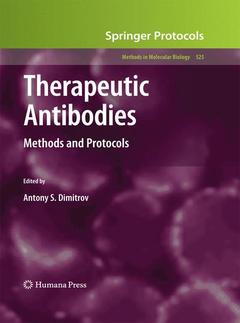Description
Therapeutic Antibodies, 2009
Methods and Protocols
Methods in Molecular Biology Series, Vol. 525
Coordinator: Dimitrov Antony S.
Language: English
Subject for Therapeutic Antibodies:
Therapeutic Antibodies
585 p. · 19.3x26 cm · Paperback
585 p. · 19.3x26 cm · Paperback
Therapeutic antibodies: methods & protocols (Methods in molecular biology, Vol. 525)
585 p. · 19.3x26 cm · Hardback
585 p. · 19.3x26 cm · Hardback
Description
/li>Contents
/li>Comment
/li>
Over 2000 years ago in China, antibodies elicited by early forms of vaccination likely played a major role in the protection of the population from infectious agents. Vac- nation has been further developed in Europe and described by Edward Jenner in the late-eighteenth century, then successfully implemented worldwide. The idea to use theactiveingredientinthebloodofvaccinated(orimmunized)animalsorhumansfor the treatment of diseases came a century later. It was made possible by a series of discoveries,suchastherealizationthattheserumfromanimalsimmunizedwithtoxins, for example, diphtheria toxin or viruses, is an effective therapeutic against the disease causedbythesameagentinhumans. Inthe1880s,vonBehringdevelopedanantitoxin (anti-body) that did not kill the bacteria but neutralized the bacterial toxin. The first Nobel Prize in Medicine (1901) was given to him for the discovery of the serum therapy. Acenturylater,22monoclonalantibodies(mAbs)areapprovedbytheUnited States Food and Drug Administration (FDA) for clinical use, and hundreds are in clinicaltrialsforthetreatmentofvariousdiseasesincludingcancers,immunedisorders, and infections. The revenues from the top-five therapeutic antibodies reached $11. 7 billion in 2006, and major pharmaceutical companies raced to acquire antibody biotech companies with a recent example of MedImmune, Inc. , which was acquired for $15. 6 billion by AstraZeneca in 2007. This explosion of research and development in the field of therapeutic antibodies prompted the publication of the MiMB volume Therapeutic Antibodies: Methods and Protocols. The book?s major goal is to present a set of protocols useful for researchers discoveringanddevelopingtherapeuticantibodies. Currentadvancesandfuturetrends in the antibody therapeutics are analyzed in thelead-in review article.
Recombinant Antigens.- Therapeutic Antibodies: Current State and Future Trends – Is a Paradigm Change Coming Soon?.- Preparation of Recombinant Viral Glycoproteins for Novel and Therapeutic Antibody Discovery.- Antibody Libraries.- Design of a Human Synthetic Combinatorial Library of Single-Chain Antibodies.- Construction of a Human Antibody Domain (VH) Library.- Generation and Selection of Rabbit Antibody Libraries by Phage Display.- Construction of a Large Naïve Human Phage-Displayed Fab Library Through One-Step Cloning.- Antibody Discovery.- Identification of Target and Function Specific Antibodies for Effective Drug Delivery.- Screening of Specific Internalization Fab Fragment from Human Naive Phage Library by Combinational Bio-Panning.- Competitive Antigen Panning for Selection of HIV-1 Neutralizing Human Monoclonal Antibodies Specific for gp41.- Selection of Non-aggregating VH Binders from Synthetic VH Phage-Display Libraries.- Isolation of Full-Length IgG Antibodies from Combinatorial Libraries Expressed in Escherichia coli.- Multiplexed Flow Cytometry: High-Throughput Screening of Single-Chain Antibodies.- Human Antibody Repertoires.- Rapid Screening Platform for Stabilization of scFvs in Escherichia coli.- Antibody Engineering.- In Vitro Antibody Affinity Maturation Targeting Germline Hotspots.- Affinity Maturation by Phage Display.- Production of Chimeric Heavy-Chain Antibodies.- Mammalian Cell Display for Antibody Engineering.- Improving Antibody Binding Affinity and Specificity for Therapeutic Development.- Construction and Production of an IgG-Like Tetravalent Bispecific Antibody for Enhanced Therapeutic Efficacy.- Deimmunization of Monoclonal Antibodies.- Anti-CD22 Onconase: Preparation and Characterization.- Antibody–Cytotoxic Agent Conjugates:Preparation and Characterization.- Antibody Preclinical Development.- High-Level Production of a Humanized ImmunoRNase Fusion Protein from Stably Transfected Myeloma Cells.- Antibody Fragment Expression and Purification.- Scaling-Up and Production of Therapeutic Antibodies for Preclinical Studies.- Antibody Production by the Gram-Positive Bacterium Bacillus megaterium.- Neutralization of HIV by Antibodies.- Dynamics of Antibody Domains Studied by Solution NMR.- In Vivo Method for Establishing Synergy Between Antibodies to Epidermal Growth Factor Receptor and Vascular Endothelial Growth Factor Receptor-2.- Passive Immunization with Human Neutralizing Monoclonal Antibodies Against HIV-1 in Macaque Models: Experimental Approaches.- Antibody Sequence Analysis.- Organizing, Exploring, and Analyzing Antibody Sequence Data: The Case for Relational-Database Managers.
Outlines the current state and future trends for therapeutic antibodies Provides complete guidelines to discover and develop therapeutic antibodies, from antigen production to animal studies Presents a modular approach with each part of the book tracing a stage of antibody discovery and preclinical development Details the most recent protocols in antibody discovery and engineering, currently used by leading academic laboratories and biotechnology companies Describes alternate approaches for antibody discovery and characterization Includes supplementary material: sn.pub/extras
© 2024 LAVOISIER S.A.S.
These books may interest you

Antibody Glycosylation 142.41 €



